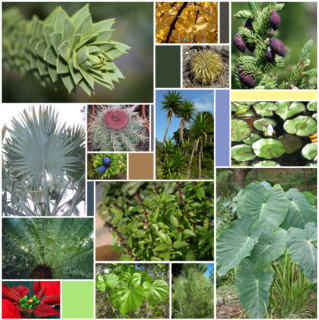
Nepenthes maxima, the great pitcher-plant, is a carnivorous pitcher plant species of the genus Nepenthes. It has a relatively wide distribution covering New Guinea, Sulawesi, and the Maluku Islands. It may also be present on Wowoni Island.

Nepenthes murudensis, or the Murud pitcher-plant, is a tropical pitcher plant endemic to Mount Murud in Borneo, after which it is named. It is of putative hybrid origin: its two original parent species are thought to be N. reinwardtiana and N. tentaculata.

Nepenthes platychila is a tropical pitcher plant endemic to the Hose Mountains of central Sarawak. It is notable for its smooth peristome and funnel-shaped upper pitchers. Nepenthes platychila belongs to the loosely defined "N. maxima complex", which also includes, among other species, N. boschiana, N. chaniana, N. epiphytica, N. eymae, N. faizaliana, N. fusca, N. klossii, N. maxima, N. stenophylla, and N. vogelii.
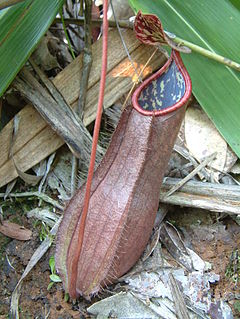
Nepenthes tomoriana is a species of pitcher plant endemic to Sulawesi, where it grows at an elevation of 0–500 m above sea level.

Nepenthes paniculata is a tropical pitcher plant belonging to the genus Nepenthes.

Nepenthes × kuchingensis is a natural hybrid between N. ampullaria and N. mirabilis. Although it is named after the city of Kuching in Sarawak, this plant has a wide distribution across Borneo, New Guinea, Peninsular Malaysia, Sumatra, and Thailand.

Nepenthes chaniana is a tropical pitcher plant species belonging to the genus Nepenthes. It is characterised by a dense indumentum of long, white hairs. Pitchers are cylindrical and mostly white to yellow in colouration. Nepenthes chaniana belongs to the loosely defined "N. maxima complex", which also includes, among other species, N. boschiana, N. epiphytica, N. eymae, N. faizaliana, N. fusca, N. klossii, N. maxima, N. platychila, N. stenophylla, and N. vogelii.
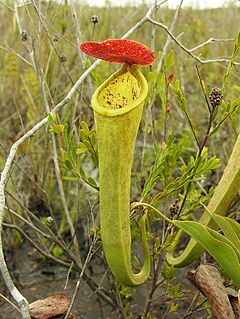
Nepenthes tenax is a lowland species of tropical pitcher plant native to northern Queensland, Australia. It is the third Nepenthes species recorded from the continent and its second endemic species. Nepenthes tenax is closely related to the two other Australian Nepenthes species: N. mirabilis and N. rowaniae.
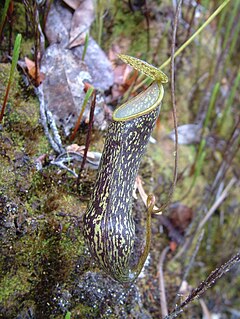
Nepenthes nigra is a tropical pitcher plant known from a number of mountains across Central Sulawesi, where it grows at elevations of 1500–2700 m above sea level. The specific epithet nigra refers to the dark colouration of the pitchers and stem. The species is closely related to N. hamata and N. tentaculata.
Stewart Robin McPherson is a British geographer, field biologist, nature photographer, and writer.
Alastair S. Robinson is an Australia-based British taxonomist and field botanist specialising in the carnivorous plant genus Nepenthes, for which he is regarded as a world authority. Robinson published the first paleogeographical evidence for the radiative speciation of an enigmatic group of ultramafic Philippine and Malaysian Nepenthes from a common ancestor on the island of Borneo.

Nepenthes palawanensis is a tropical pitcher plant endemic to Sultan Peak on the island of Palawan in the Philippines, where it grows at elevations of 1100–1236 m above sea level. It was discovered in February 2010 by Jehson Cervancia and Stewart McPherson.

Pitcher Plants of the Old World is a two-volume monograph by Stewart McPherson on the pitcher plants of the genera Nepenthes and Cephalotus. It was published in May 2009 by Redfern Natural History Productions and covers all species known at the time. The work was edited by Alastair Robinson and Andreas Fleischmann.
Nepenthes appendiculata is a tropical pitcher plant known only from the Hose Mountains of central Sarawak, Borneo, where it grows at elevations of 1450–1700 m above sea level. The species is characterised by an enlarged glandular appendage on the lower lid surface, for which it is named.
Nepenthes epiphytica is a tropical pitcher plant known only from the Berau and East Kutai Regencies of East Kalimantan, Borneo, where it grows at an elevation of around 1000 m above sea level. Prior to its formal description as a species, N. epiphytica was considered to be a variant of the closely related N. fusca. Nepenthes epiphytica belongs to the loosely defined "N. maxima complex", which also includes, among other species, N. boschiana, N. chaniana, N. eymae, N. faizaliana, N. fusca, N. klossii, N. maxima, N. platychila, N. stenophylla, and N. vogelii.
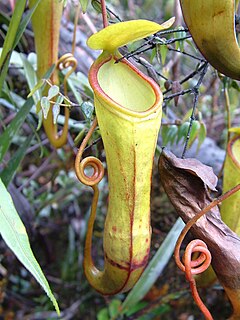
Nepenthes monticola is a tropical pitcher plant known from a number of mountains in the west central highlands of West Papua, New Guinea, where it grows at elevations of 1400–2620 m above sea level. Prior to its description as a species in 2011, N. monticola was lumped with the closely related N. lamii.

New Nepenthes: Volume One is a reference work by Stewart McPherson on the pitcher plants of the genus Nepenthes. It was published in 2011 by Redfern Natural History Productions and focuses on discoveries made since the release of McPherson's 2009 monograph, Pitcher Plants of the Old World. The book was edited by Alastair Robinson.


